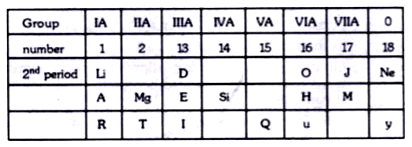
In the above table - H does not represent hydrogen. Some elements are in their own symbol & position in the periodic table while others are shown with a letter. Identify
Which element from group 2 would have the least ionization energy.
Step by step video & image solution for In the above table - H does not represent hydrogen. Some elements are in their own symbol & position in the periodic table while others are shown with a letter. Identify Which element from group 2 would have the least ionization energy. by Chemistry experts to help you in doubts & scoring excellent marks in Class 10 exams.
Updated on:21/07/2023Topper's Solved these Questions
- PERIODIC TABLE (PERIODIC PROPERTIES AND VARIATION OF PROPERTIES)BOOK - ICSECHAPTER - PERIODIC TABLE (PERIODIC PROPERTIES AND VARIATION OF PROPERTIES)EXERCISE - ADDITIONAL QUESTIONS
74 Videos
- PERIODIC TABLE (PERIODIC PROPERTIES AND VARIATION OF PROPERTIES)BOOK - ICSECHAPTER - PERIODIC TABLE (PERIODIC PROPERTIES AND VARIATION OF PROPERTIES)EXERCISE - ADDITIONAL QUESTIONS (Fill in the blanks with the appropriate word/s in each case.)
24 Videos
- PERIODIC PROPERTIES AND VARIATIONS OF PROPERTIESBOOK - ICSECHAPTER - PERIODIC PROPERTIES AND VARIATIONS OF PROPERTIESEXERCISE - ASSERTION AND REASON BASED QUESTIONS
5 Videos
- PRACTICAL CHEMISTRY BOOK - ICSECHAPTER - PRACTICAL CHEMISTRY EXERCISE - Questions from Previous ICSE Board Papers (2017)
2 Videos
Similar Questions

In the above table - H does not represent hydrogen. Some elements are in their own symbol & position in the periodic table while others are shown with a letter. Identify
The element from period 3 with least atomic size.
View Solution
In the above table - H does not represent hydrogen. Some elements are in their own symbol & position in the periodic table while others are shown with a letter. Identify
The most reactive element of group I.
View Solution
In the above table - H does not represent hydrogen. Some elements are in their own symbol & position in the periodic table while others are shown with a letter. Identify
How many valence electrons are present in Q.
View Solution
In the above table - H does not represent hydrogen. Some elements are in their own symbol & position in the periodic table while others are shown with a letter. Identify
In the compound between A & H what type of bond is formed & give its molecular formula.
View Solution
• In this table H does not represent hydrogen.
• Some elements are given in their own symbol and position in the periodic table.
• While others are shown with a letter.
With reference to the table answer the following questions :
Identify the most reactive element of group 1.
View Solution
• In this table H does not represent hydrogen.
• Some elements are given in their own symbol and position in the periodic table.
• While others are shown with a letter.
With reference to the table answer the following questions :
Identify the most electronegative element.
View Solution
• In this table H does not represent hydrogen.
• Some elements are given in their own symbol and position in the periodic table.
• While others are shown with a letter.
With reference to the table answer the following questions :
Identify the noble gas of the fourth period.
View Solution
• In this table H does not represent hydrogen.
• Some elements are given in their own symbol and position in the periodic table.
• While others are shown with a letter.
With reference to the table answer the following questions :
Identify the element from period 3 with least atomic size.
View Solution
• In this table H does not represent hydrogen.
• Some elements are given in their own symbol and position in the periodic table.
• While others are shown with a letter.
With reference to the table answer the following questions :
How many valence electrons are present in Q?
View Solution
In this table H does not represent hydrogen.
Some elements are given in their own symbol and position in the periodic table.
While others are shown with a letter.
With reference to the table answer the question :
Identify the least reactive element of group 1.
View Solution
